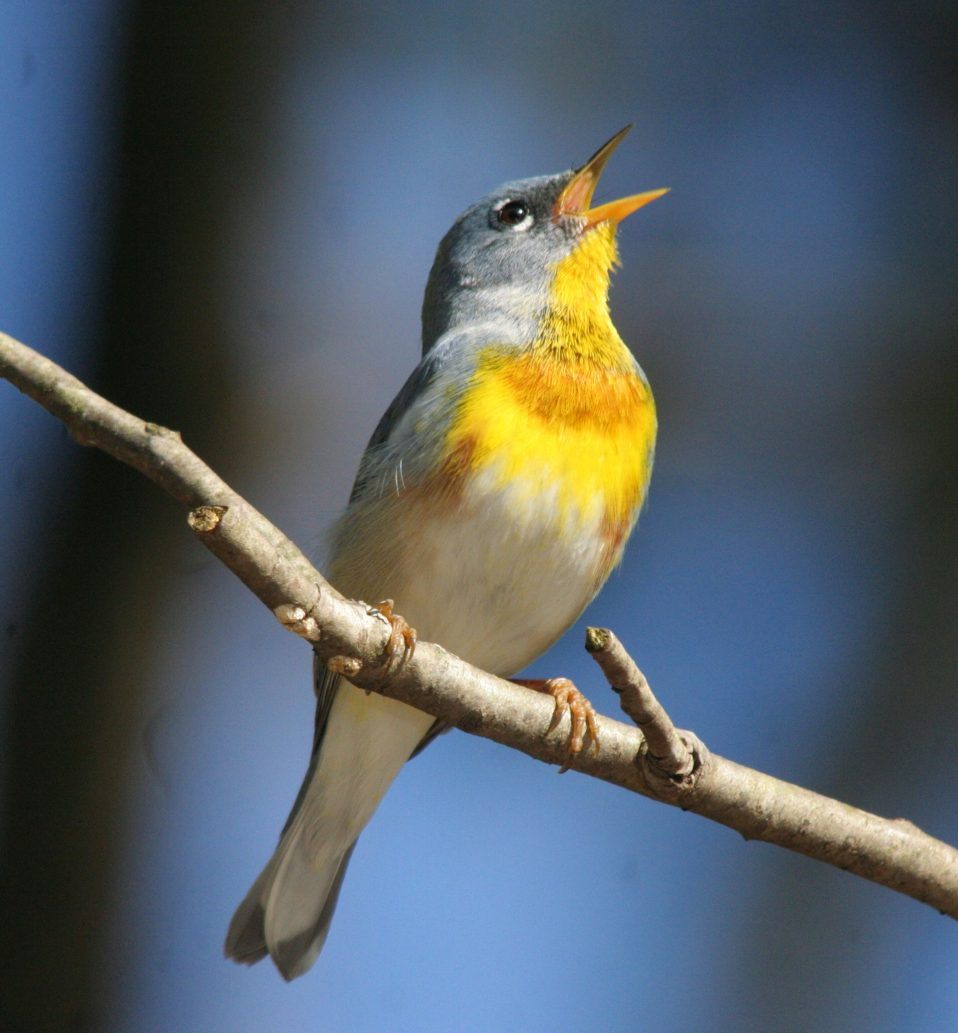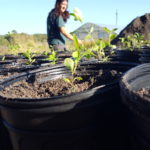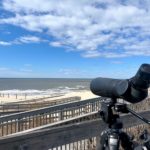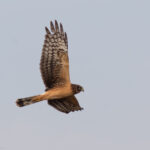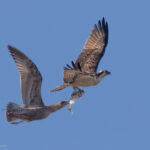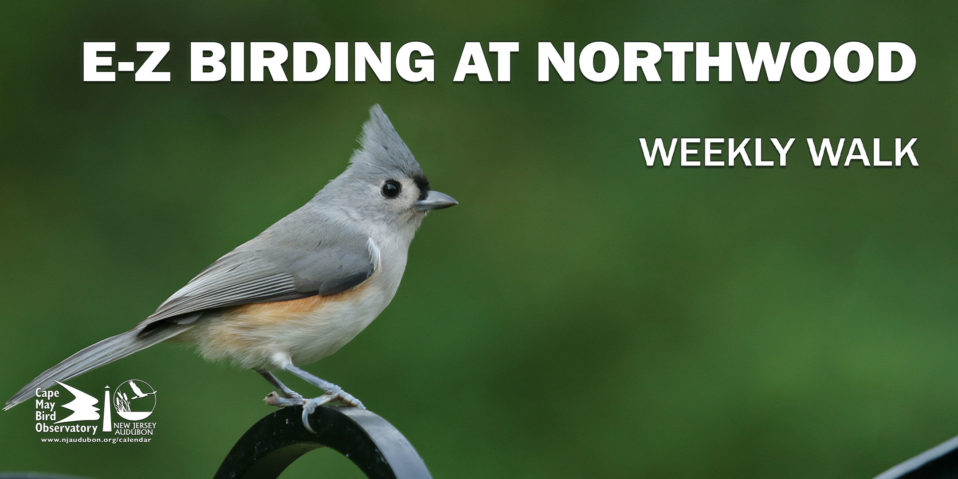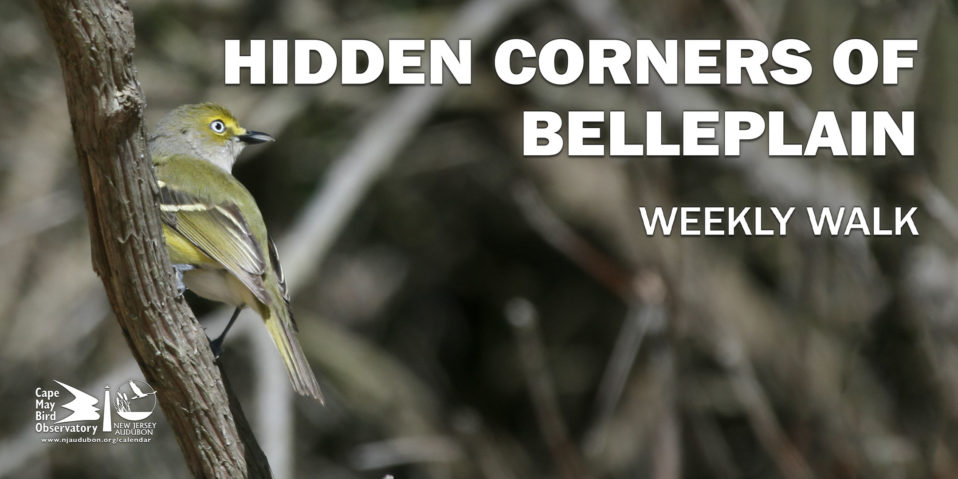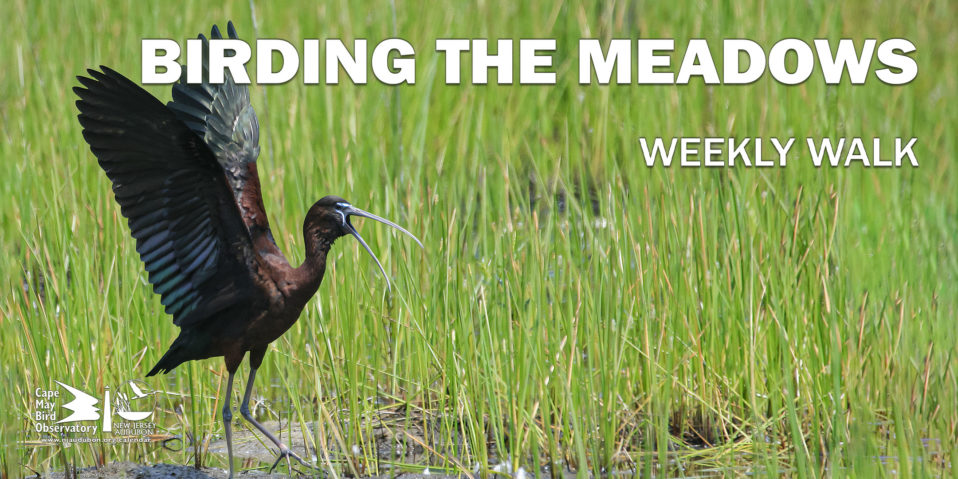By Steven Garcia, Stewardship Technician
New Jersey Audubon continues to restore and create habitat throughout New Jersey. In light of the Covid-19 pandemic, we have adapted new approaches and strict guidelines to ensure staff, partners, and the public are protected. These guidelines allow us to continue the important work of our mission while making health and safety a top priority. One such effort includes our restoration project at Cape May Point State Park. This long-term project aims to restore 25 acres of maritime forest that has been heavily impacted by non-native invasive plants. These aggressive species impact the health of the forest by outcompeting native plants that benefit wildlife and people.
Cape May Point State Park: A Place to Rest and Refuel
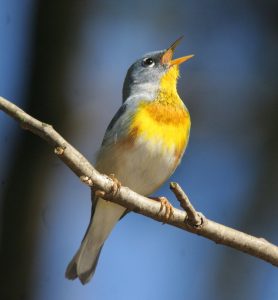
Northern Parula is among the many species of birds that use the habitat of Cape May Point State Park. Photo by Dustin Welch
Cape May Point State Park is a 244-acre area nestled in the southernmost tip of Cape Island. The park offers wonderful diversity of beaches, dunes, coastal marshes, ponds, maritime forests, and historic structures. The mosaic of habitats support many bird species year-round, with eBird reporting 364 species seen in the park alone! The park is most important during fall migration when northwesterly winds funnel southbound migrants into the Cape May Peninsula. From here, migrants rest and refuel, using many of the vital resources Cape May Point State Park provides before continuing south towards their wintering grounds.
The importance of Cape May Point State Park to migrating birds in unequivocal; however, the important services the park provides have been under attack. The culprits of these attacks are non-native invasive plants that aggressively spread and smother native plants. These species arrived here either accidently (e.g. shipping containers) or intentionally (e.g. landscaping) and have quickly escaped and spread throughout the landscape.
Alien Plant Invaders Take Over the Park
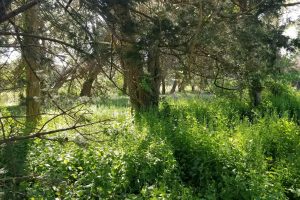
Garlic mustard is one of the many non-native invasive plants that threaten Cape May Point State Park. Photo by Steven Garcia
Over the years, these invaders have completely overwhelmed sections of Cape May Point State Park. Non-native invasive plants carpet large sections of habitat, smothering existing native plants and preventing the growth of new ones. When non-native invasive plants push out native species, the results are detrimental. In fact, one of the top threats to wildlife in New Jersey are non-native invasive species. Native plants have a unique relationship with the native insects of North America. Over time, this shared evolutionary history has created the complex food web we see today. Unfortunately, non-native invasive plants do not have that same shared relationship with native insects. When a non-native invasive plant displaces a native one, an important piece of the puzzle is taken away. Once a natural area is dominated by non-native invasive plants, food availability because scarce, creating what is known as a “food desert.”

Porcelain berry is another non-native invasive plant that threatens Cape May Point State Park. Photo by Danielle Bara
In addition to the lack of food, non-native invasive plants degrade habitat structure, meaning the different plant layers found in forests and other habitats. This is detrimental to wildlife that may need certain types of cover to nest and to move through areas safely. Some non-native invasive plants can also change the chemistry of the soil they inhabit, negatively affecting native plants around them. An example of this is Garlic Mustard (Alliaria petiolata), which prevents other plants from growing around it by affecting the mycorrhizal fungi critical for the nutrient uptake of our native trees. Given enough time, the suppression of native regeneration on the ground layer causes the shrub and canopy layers to collapse. Non-native invasive vines will also choke out trees and shrubs, accelerating the collapse of habitat. Without intervention, these areas ultimately turn into a monoculture of non-native invasive plants.
Restoring the Forest for People and Wildlife
With the collapse of important habitat at Cape May Point State Park, New Jersey Audubon has partnered with the New Jersey Division of Parks and Forestry to restore the health of the 25-acre forest patch along Seagrove and Lighthouse Avenues. Funding provided by the National Fish and Wildlife Foundation, U.S. Fish and Wildlife Service, Atlantic City Electric, and generous private donations have supported restoration efforts since 2010. Initially focused on a small section within the 25-acres, New Jersey Audubon utilized a variety of tools and strategies, including a forestry mower, herbicide application, and volunteer efforts to selectively remove invasive species. After years of consistent management native plants are beginning to sprout from the soil as light and other resources become available once again.

Forestry mowing helps to reduce to amount of non-native invasive plants. Photo by Steven Garcia
Recently, thanks to a grant provided by the U.S. Forest Service and secured by the New Jersey Invasive Species Strike Team, the restoration of this forest is continuing. The increased funding allowed New Jersey Audubon to conduct forestry mowing of invasive shrubs and vines on a 12-acre section of the forest in March of 2019. Restoration decisions like this are carefully thought out and supported by science to maximize the efficacy of our actions. Forestry mowing occurs in late winter so that overwintering habitat is kept intact right up until spring green-up, reducing the disturbance of the operation. These mowing operations are also completed iteratively and completed in stages to ensure there is always cover for wildlife during the restoration process.
Although forestry mowing is a critical step, it often does not actually kill non-native invasive plants. In fact, cutting plants can stimulate growth, which is why herbicide applications follow forestry mowing. Forestry mowing is designed to reduce the amount of herbicide used later, allowing for effective and safe herbicide applications. By properly applying herbicides to non-native invasive plants, trained and licensed staff can disrupt the growth of these aggressive species. The use of herbicide is critical to the success of restoration projects like these. All herbicide applications follow best management practices and staff take great care to target non-native invasive plants. Ultimately, we use these management techniques to slowly reduce the need for mowing and herbicide applications over time. When done properly, these management techniques can drastically reduce pressure non-native invasive plants have on native species. Providing native plants with ample resources will eventually allow them to re-establish and become resilient against non-native invasive plants.
Seeds for Success: Replanting Cape May Point State Park

Native shrubs are planted at Cape May Point State Park. Photo by Steven Garcia
While natural native regeneration can and does occur following these management actions, New Jersey Audubon is also helping the habitat along by planting native shrubs in areas where invasive plant control has been effective. Planting native species for restoration is not unique, but New Jersey Audubon is taking a unique approach. At Cape May Point State Park, we are using plants that are sourced from native populations throughout Cape May County, making them highly adapted to local conditions. Recently, some of these locally sourced shrubs made their way to Cape May Point State Park. In early May of 2020, staff planted Arrowood Viburnum (Viburnum dentatum) and Red Chokeberry (Aronia arbutifolia) where invasive plant control has been successful. Staff then placed a protective tube over each shrub. This added layer of protection reduces browse by animals while allowing the shrubs to thrive and spread.
New Jersey Audubon will continue to beat back non-native invasive plants here at Cape May Point State Park to restore this forest for New Jersey’s plants, wildlife, and people. Do you want to learn how you can get involved? Contact Steven Garcia, Stewardship Technician, [email protected] to join our mailing list for upcoming volunteer days and check out our project page at https://njaudubon.org/cape-may-point/ for information!




